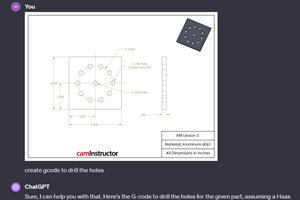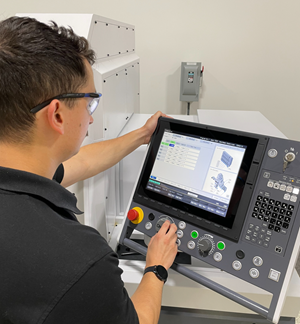Can AI Replace Programmers? Writers Face a Similar Question
The answer is the same in both cases. Artificial intelligence performs sophisticated tasks, but falls short of delivering on the fullness of what the work entails.
Share





A recent post by senior editor Julia Hider explores the use of the artificial intelligence (AI) tool ChatGPT to automatically generate G-code programming. That article flirts with the question of whether AI can replace CNC programmers. Spoiler alert: It can’t, even though it can aid them by automating certain aspects of what they do.
That implied question in the article leaps out at me, because it reminds me of a very similar question that Julia and I, and all the writing staff of this site, face in our own work. Indeed, I suspect this question arises more frequently, because while many have explored programming via ChatGPT, a larger number have seen this resource produce coherent composition in response to prompts. The question that arises is: Can AI replace writers?
My response, which in a sense also applies to programmers (I will come back to them) is this: It depends on what you imagine writers to be doing.
AI can definitely write. There is little disputing this. As anyone who has played with ChatGPT knows, the platform produces credible composition. It now seems apparent that if there is any formula to a category of writing, no matter how subtle, AI can find and follow the formula. The rules of grammar and the expectations of sentence rhythm and paragraph structure are followed, and formal and informal rules of style are followed as well. ChatGPT can write in the form of haiku, essay, a technical paper, a campaign speech and more. That the writing it generates is “credible” does not mean the composition is accurate or useful to the spirit of the prompt, yet even success along these measures will improve.
But does any of this suggest that AI has the capability, or even the potential, to take over for writers in the fullness of the work they do?
Here is what I think my work as a writer entails: I am to see and explore developments and ideas it would be valuable for my readers to understand. I am to cultivate curiosity about what interests them, so I can pose questions they would ask if they were with me. I am to find the meaning in what I am experiencing and convey that insight to them.
There is a lot in that description. First, there are the readers, the human beings my writing serves. Then there is meaning, which I hope to discover and convey. What we call “artificial intelligence” is a machine of a sort — a set of algorithms able to craft new algorithms as part of the way it calculates toward the solution to a specified input problem — but it still needs that input problem. And I don’t need this. Instead, I am learning about human beings as part of my life, and learning how to better serve them as part of my life’s work.
You might sense how far this analysis goes. For writers, for programmers — for everyone — the questions about the possibilities for AI come to whether “artificial” intelligence can take over for what real (for lack of a better word) intelligence does. I mentioned meaning: Where does this come from? Is it to be found, or can meaning “emerge” from an algorithm’s written piece that is complex enough? This question, and its answer, are similar to the question of where intelligence itself comes from. Can “real” intelligence emerge from a sufficiently complex algorithm?
You did not come here expecting a philosophy treatise, so let me skip ahead to my answer: I think I am a soul. Not a machine. I think a soul is what you are, too. Therefore, for me, I understand machine “intelligence” to be a tool, but something that can never come to actual intelligence in terms of crafting its own inputs so that people are truly served. Machines cannot produce souls by computing faster, and by extension, machines cannot generate the kind of meaning these souls seek and share with one another.
This brings us well beyond writers and writing. Serving people, finding meaning — not just writers do this, but artists, craftspeople, inventors, scientists and CNC programmers as well, among many others.
AI can program. Yet it can’t replace programmers. It likely can compose the G-code sequence for a drilling and tapping routine based on input parameters, and in the future, it will reliably compose more complex code than this. But that input is the precondition. The programmer is the one considering questions such as: Are we assuming the right setup and sequence of operations? Are our priorities right, or would a different balance between cycle time and tool selection make sense? Do I know something about other parts in the shop that relates to how this one should be run? And sometimes: Is machining even the right process? All this is part of the exploration that allows programming to realize its purpose for people (the people who want these parts), and all of this is part of the meaning surrounding any particular problem in machining. Thus, while we MMS writers will continue watching and reporting on the advance of AI as a programming tool, it can only be the case that we will always be writing for a programmer, a human, who is using that tool.
Related Content
Continuous Improvement and New Functionality Are the Name of the Game
Mastercam 2025 incorporates big advancements and small — all based on customer feedback and the company’s commitment to keeping its signature product best in class.
Read MoreThe Power of Practical Demonstrations and Projects
Practical work has served Bridgerland Technical College both in preparing its current students for manufacturing jobs and in appealing to new generations of potential machinists.
Read MoreCan ChatGPT Create Usable G-Code Programs?
Since its debut in late 2022, ChatGPT has been used in many situations, from writing stories to writing code, including G-code. But is it useful to shops? We asked a CAM expert for his thoughts.
Read MoreSwiss-Type Control Uses CNC Data to Improve Efficiency
Advanced controls for Swiss-type CNC lathes uses machine data to prevent tool collisions, saving setup time and scrap costs.
Read MoreRead Next
A New Frontier in Surface Finish Control
What if your machine tool could measure surface roughness as it cuts? This article explores how in-process metrology is advancing from concept to reality, enabling real-time feedback, immediate detection of anomalies and new levels of control over surface quality. Discover the technologies making this possible.
Read MoreHow I Made It: Dennis Rymanowski
Dennis Rymanowski has worked at NSH USA for 60 years, with his passion for manufacturing living alongside his passion for his family’s polka band.
Read More






















